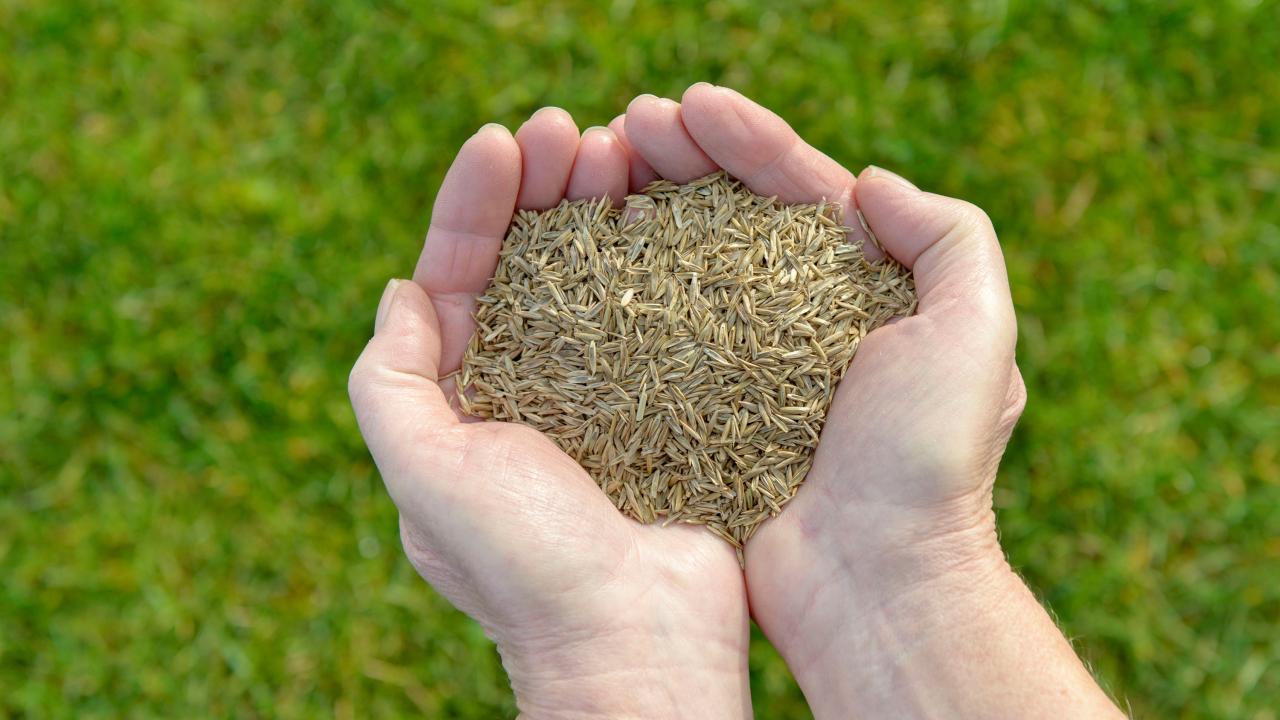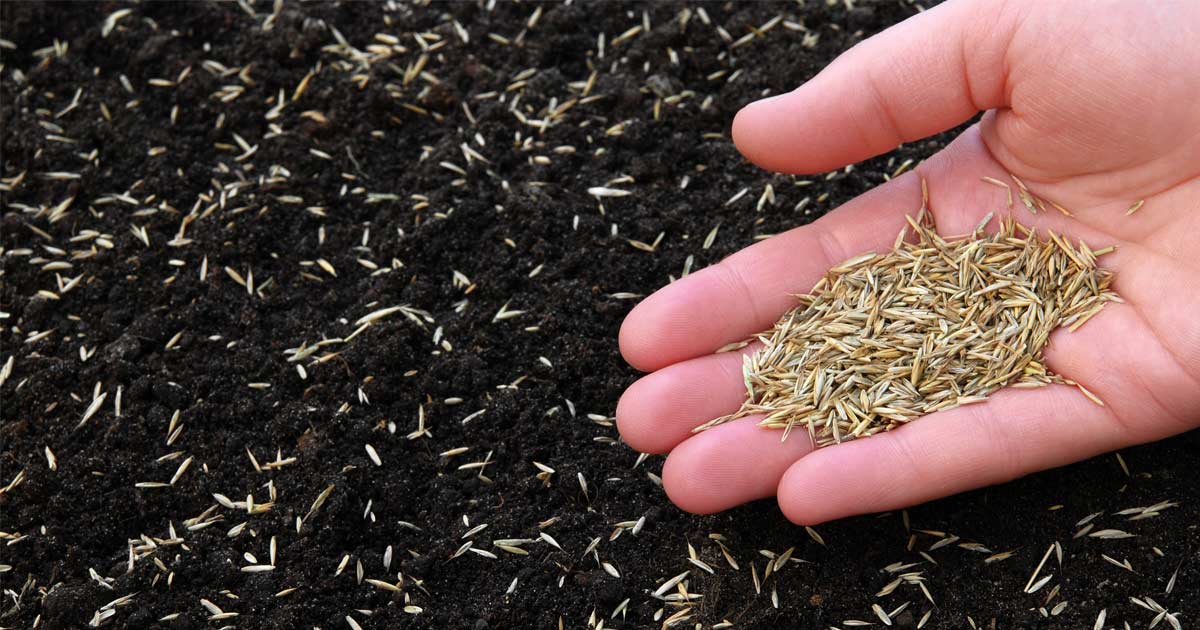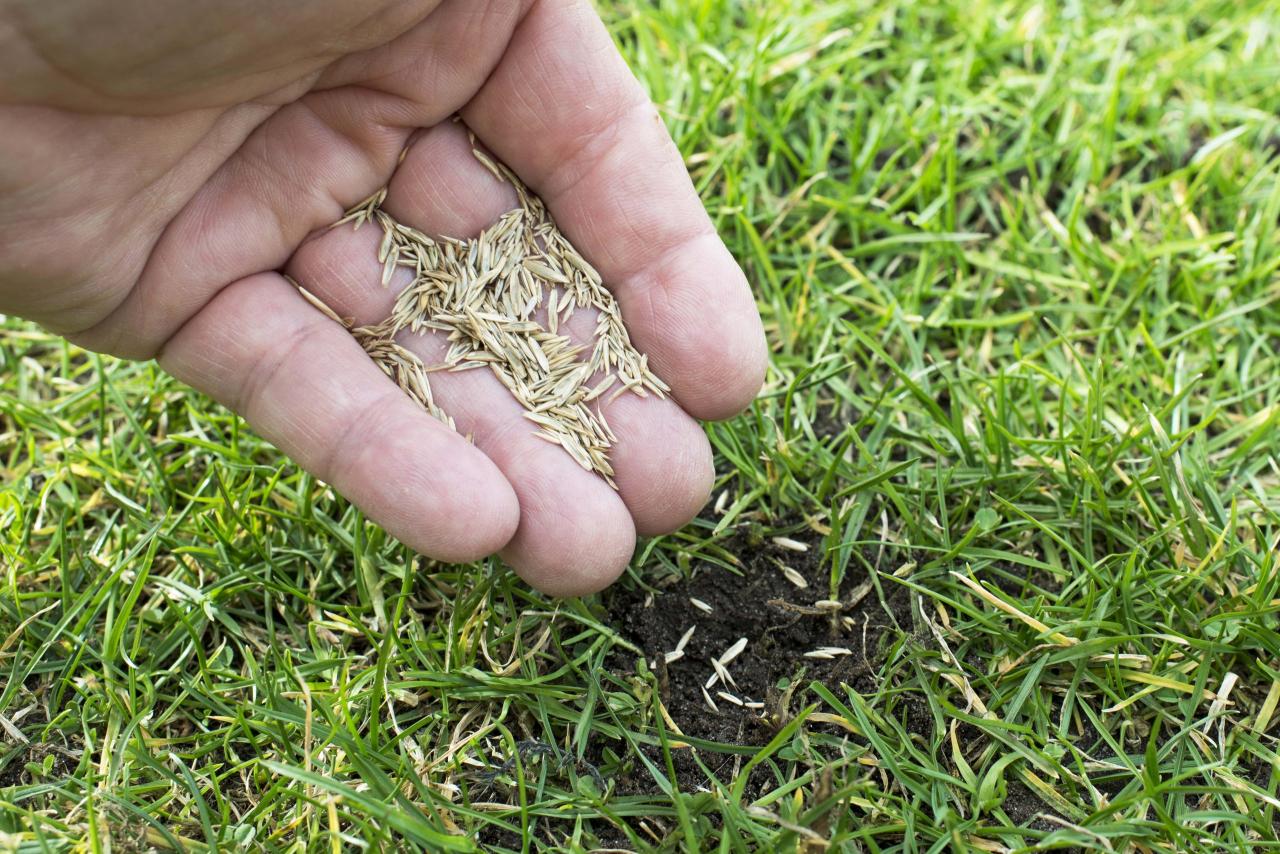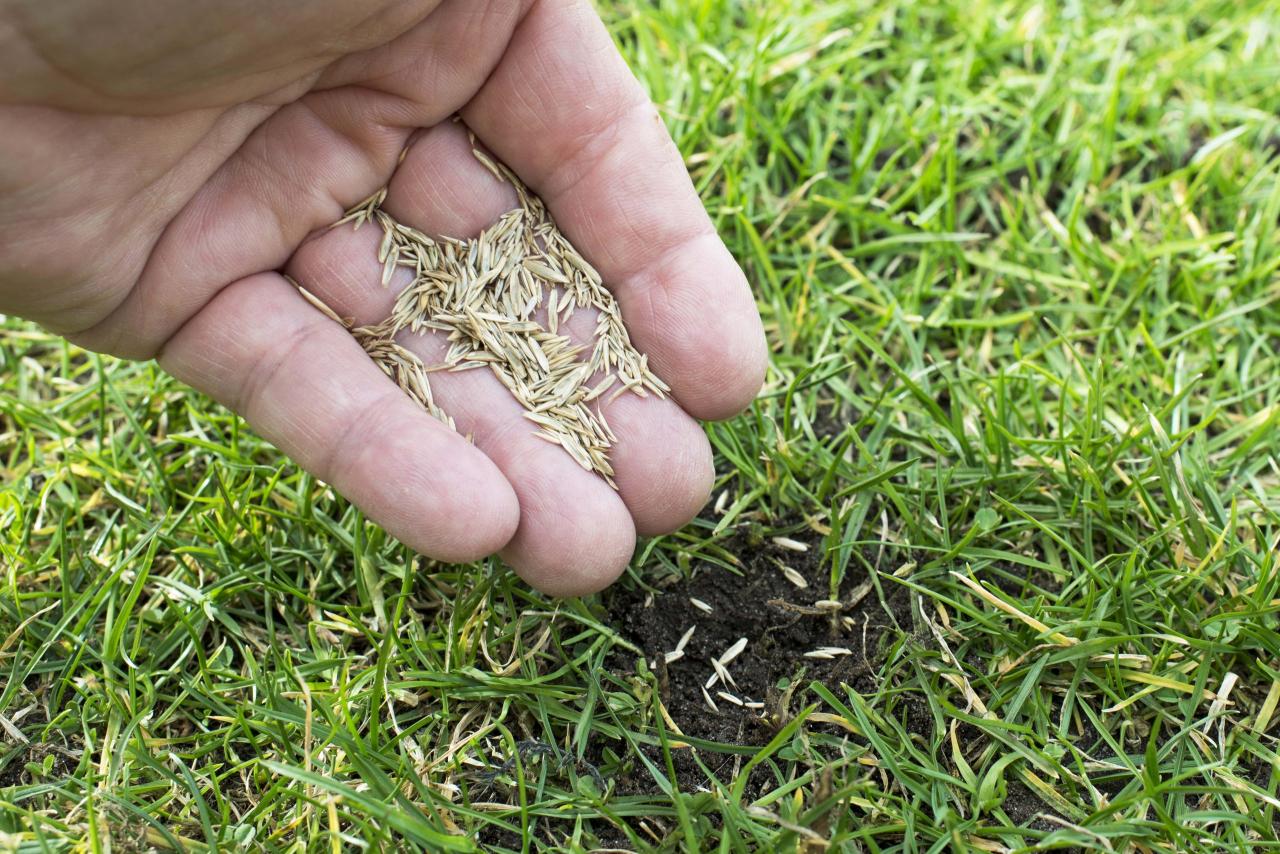The Ideal Times to Sow Grass Seed: Tips for a Thriving Lawn – a lush, green lawn is the dream of many homeowners, but achieving that dream often hinges on understanding the best time to sow grass seed. The success of your lawn hinges on timing, as the ideal window for planting depends on your climate and the specific grass type you’re using.
This article delves into the science behind optimal grass seed germination, exploring the best times for sowing in both spring and fall, and providing tips for preparing the soil and nurturing your new lawn.
From the optimal temperature range for seed germination to the proper watering schedule, we’ll cover all the essentials for a thriving lawn. We’ll also discuss common problems that can arise during germination and provide solutions for addressing them. Whether you’re a seasoned gardener or a novice, this comprehensive guide will equip you with the knowledge and tools to achieve a beautiful and healthy lawn.
Understanding the Ideal Timing

Timing is crucial for successful grass seed germination, just like planting a seed at the right time in the garden. The success of your lawn hinges on getting the timing right. It’s all about giving your grass seeds the best possible environment to sprout and thrive.
Temperature and Moisture for Grass Seed Growth
Temperature and moisture are the key factors that influence grass seed germination. These two elements work together to create the perfect environment for your grass seeds to sprout and grow.
- Temperature:Grass seeds need a certain temperature range to germinate. This range varies depending on the type of grass. Cool-season grasses, like Kentucky bluegrass and perennial ryegrass, prefer cooler temperatures, typically between 60°F and 75°F (15°C and 24°C). Warm-season grasses, such as Bermuda grass and zoysia grass, thrive in warmer temperatures, generally between 70°F and 85°F (21°C and 29°C).
- Moisture:Grass seeds need consistent moisture to germinate. The soil should be consistently moist, but not soggy. Too much moisture can suffocate the seeds, while too little moisture can cause them to dry out and die.
Optimal Temperature Ranges for Different Grass Types
Here is a table that Artikels the optimal temperature ranges for different types of grass:
Grass Type |
Optimal Temperature Range (°F) |
Optimal Temperature Range (°C) |
|---|---|---|
Cool-Season Grasses |
60°F
|
15°C
|
Warm-Season Grasses |
70°F
|
21°C
|
Ideal Soil Moisture Levels for Seed Germination
The ideal soil moisture level for seed germination is when the soil is consistently moist but not waterlogged. A good way to test the soil moisture is to stick your finger about an inch into the soil.
If the soil feels cool and moist, it is likely at the right moisture level.
“The ideal soil moisture level for seed germination is when the soil is consistently moist but not waterlogged.”
Spring Sowing

Spring is a popular time to sow grass seed, as the weather starts to warm up and the ground thaws. The ideal time to sow grass seed in the spring will vary depending on your location, but generally, you should aim to sow between late March and early May.
Ideal Spring Sowing Window
The ideal spring sowing window is when the soil temperature has warmed up to at least 50 degrees Fahrenheit (10 degrees Celsius) and the threat of frost has passed. The soil should also be moist but not waterlogged. You can use a soil thermometer to check the soil temperature.
Benefits of Early Spring Sowing
Sowing grass seed in early spring has several advantages.
- Warm Weather:Early spring offers warmer temperatures, which promotes faster germination and growth.
- Moist Soil:The soil is typically moist from winter rains, providing ideal conditions for seed germination.
- Less Competition:There is less competition from weeds in early spring, allowing your new grass to establish itself more easily.
Challenges of Late Spring Sowing, The Ideal Times to Sow Grass Seed: Tips for a Thriving Lawn
Sowing grass seed in late spring can be more challenging due to the following factors:
- Hot Temperatures:Hot temperatures can dry out the soil quickly, making it difficult for seeds to germinate and establish.
- Increased Weed Competition:Weeds start to grow more vigorously in late spring, competing with your new grass for resources.
- Drought:Late spring can be a dry time of year in some regions, which can make it difficult to keep the soil moist enough for germination.
Early vs. Late Spring Sowing
Factor |
Early Spring Sowing |
Late Spring Sowing |
|---|---|---|
Soil Temperature |
Warmer temperatures promote faster germination |
Potentially cooler temperatures can slow down germination |
Moisture |
Moist soil from winter rains aids germination |
Dryer soil can make it challenging to maintain moisture |
Weed Competition |
Less weed competition allows grass to establish easily |
Increased weed competition can hinder grass growth |
Overall Success |
Higher chance of successful establishment |
Higher risk of failure due to heat, dryness, and weeds |
Fall Sowing: The Ideal Times To Sow Grass Seed: Tips For A Thriving Lawn

Fall sowing, the practice of planting grass seed in the autumn, offers several advantages for cultivating a lush and healthy lawn. This technique leverages the cooler temperatures and increased moisture of fall to promote strong root development and a thicker, more resilient turf.
Optimal Fall Sowing Window
The ideal fall sowing window varies depending on your climate. Generally, aim to sow grass seed at least six weeks before the first expected frost. This allows sufficient time for the seeds to germinate and establish a strong root system before the ground freezes.
- Northern Climates:In regions with cold winters, the best time to sow grass seed is typically between late August and mid-September.
- Southern Climates:In warmer climates with milder winters, the window for fall sowing can extend into October or even early November.
Preparing the Soil for Fall Sowing
Preparing the soil is crucial for successful fall sowing.
- Remove Existing Vegetation:Clear any existing grass or weeds from the area where you plan to sow. This can be done by mowing low, using a dethatcher to remove thatch, or applying a pre-emergent herbicide.
- Aerate the Soil:Aeration helps improve drainage and allows the roots to penetrate deeper. Core aeration is a common method, where small plugs of soil are removed.
- Test Soil pH:The ideal soil pH for most grasses is between 6.0 and 7.0. Use a soil test kit to determine your soil’s pH and adjust it accordingly.
- Amend the Soil:If your soil is compacted or lacks nutrients, amend it with compost or other organic matter to improve its structure and fertility.
Importance of Overseeding in the Fall
Overseeding in the fall is a valuable practice that can help thicken your lawn and improve its overall health.
Timing is everything when it comes to achieving a lush, green lawn. Just as understanding the optimal time to sow grass seed is crucial for success, knowing when to harvest and use perilla leaf is essential for creating flavorful and nutritious dishes.
For guidance on incorporating this versatile herb into your culinary creations, check out How to Cook with Perilla Leaf: Essential Tips for Flavorful and Nutritious Recipes. Once you’ve mastered the art of perilla leaf cooking, you can return to your lawn care routine with renewed vigor, armed with the knowledge of the ideal times to sow your grass seed for a thriving lawn.
- Fill in Thin Spots:Fall sowing helps fill in bare patches or thin areas that have become sparse during the summer months.
- Promote Thick Turf:New grass seedlings will have the entire fall and early spring to develop a strong root system, leading to a thicker, more resilient turf.
- Reduce Weed Competition:A dense lawn provides less opportunity for weeds to establish themselves.
Preparing the Soil
A healthy lawn starts with healthy soil. The soil provides essential nutrients and water for your grass, and its structure influences drainage and aeration. Before sowing grass seed, it’s crucial to assess and prepare your soil to ensure optimal growth conditions.
Soil Testing
Soil testing is a valuable tool for understanding your soil’s composition and identifying any deficiencies. A soil test can reveal the pH level, nutrient content, and texture, providing valuable insights into the specific needs of your lawn. This information helps you tailor your soil amendments to create the ideal environment for your grass seed.
Amending the Soil
Once you have the results of your soil test, you can start amending the soil to create the best possible environment for your grass seed.
Common Soil Amendments and Their Benefits
- Compost:A rich organic matter that improves soil structure, aeration, and water retention. It also adds essential nutrients to the soil, promoting healthy root development.
- Peat Moss:A natural soil amendment that improves drainage and aeration, particularly in heavy clay soils. It also helps to retain moisture, which is beneficial for newly sown grass seed.
- Lime:Used to raise the pH of acidic soil, making it more hospitable for most grass varieties. It also helps to improve nutrient availability in the soil.
- Sulphur:Used to lower the pH of alkaline soil, making it more suitable for certain grass species. It also helps to improve nutrient uptake.
- Fertilizers:Provide essential nutrients like nitrogen, phosphorus, and potassium to support healthy grass growth. Choosing a fertilizer specifically formulated for new lawns ensures adequate nutrient supply for establishing a thriving turf.
Creating a Healthy Soil Structure
- Tilling:Breaking up compacted soil to improve aeration and drainage, allowing roots to grow freely and access nutrients more effectively.
- Raking:Removing debris, thatch, and unwanted vegetation from the soil surface, creating a clean and level surface for sowing grass seed.
- Watering:Moistening the soil before sowing grass seed helps the seeds germinate and establish roots. Consistent watering is essential for new grass, especially during the initial stages of growth.
Sowing Techniques
After preparing the soil, the next step is to sow the grass seed. There are several methods for sowing grass seed, each with its own advantages and disadvantages. Choosing the right method depends on the size of your lawn, the type of grass seed you’re using, and your personal preference.
Broadcast Sowing
Broadcast sowing is the most common method of sowing grass seed. It involves scattering the seed evenly over the prepared soil. This method is simple and quick, making it ideal for large lawns.
For best results, use a broadcast spreader to ensure even seed distribution.
A broadcast spreader is a tool that helps you evenly distribute the grass seed over the entire lawn. It is usually a handheld device with a hopper that holds the seed and a mechanism that dispenses the seed at a controlled rate.
Overseeding
Overseeding involves sowing grass seed over an existing lawn. This is a good way to thicken up a thin lawn or to introduce new varieties of grass. Overseeding is often done in the fall when the existing grass is dormant.
For overseeding, use a drop spreader or a rotary spreader.
A drop spreader is a device that drops seed directly onto the soil, while a rotary spreader spins the seed out over the lawn. Both types of spreaders can be used for overseeding.
Hand Sowing
Hand sowing is a method that involves scattering the seed by hand. This method is best for small lawns or areas where a spreader cannot be used. Hand sowing requires patience and care to ensure even seed distribution.
Use a small cup or bowl to scoop out the seed and gently scatter it over the soil.
Tips for Achieving Even Seed Distribution
Regardless of the method you choose, there are some tips to ensure even seed distribution and a healthy lawn:
-
Divide the seed into multiple bags or containers and sow in overlapping passes.
-
Walk in different directions with each pass to avoid creating a pattern.
-
Use a seed rake or a light brush to gently work the seed into the soil.
Post-Sowing Care
After meticulously sowing your grass seed, the next crucial step is providing the right care to ensure a healthy and thriving lawn. Proper post-sowing care involves consistent watering, preventing soil compaction, and implementing essential lawn care practices.
Watering After Sowing
Watering is essential for seed germination and the establishment of a healthy root system. Immediately after sowing, water the seedbed thoroughly but gently. The goal is to moisten the soil without dislodging the seeds.
Watering Schedule for Newly Sown Grass
The watering schedule for newly sown grass varies depending on factors like climate, soil type, and seed variety. However, a general guideline is to water the seedbed twice daily, once in the morning and once in the evening.
- During the initial germination phase, keep the soil consistently moist but not waterlogged.
- As the grass seedlings emerge, gradually reduce the watering frequency to once daily, allowing the soil to dry slightly between waterings.
- Once the grass has established a strong root system, you can further reduce watering frequency to a few times a week, depending on weather conditions.
Preventing Soil Compaction
Soil compaction can hinder root growth and lead to poor drainage.
- Avoid walking on the newly sown lawn until the grass has established itself.
- Use a garden rake to gently aerate the soil, which allows for better air and water penetration.
- Consider applying a layer of mulch, such as straw or wood chips, to help retain moisture and prevent soil compaction.
Lawn Care Practices for a Thriving Lawn
Following these lawn care practices will contribute to a healthy and vibrant lawn:
- Mowing:Once the grass has grown to a height of 3-4 inches, mow it regularly to encourage lateral growth and prevent the formation of thatch.
- Fertilizing:Apply a balanced fertilizer to provide essential nutrients for healthy growth. Avoid over-fertilizing, which can lead to excessive growth and disease.
- Weed Control:Regularly remove weeds to prevent them from competing with your grass for nutrients and water.
- Pest Control:Monitor your lawn for pests like grubs, chinch bugs, and armyworms. Treat infestations promptly to prevent damage to your grass.
- Disease Prevention:Maintain good lawn care practices to prevent the spread of diseases.
Troubleshooting
Even with careful planning and execution, challenges can arise during grass seed germination. Understanding common problems and their causes is crucial for successful lawn establishment. This section will delve into identifying these issues, explaining their origins, and providing solutions for addressing them.
Additionally, preventive measures will be discussed to minimize future occurrences.
Identifying and Addressing Common Problems
Identifying the underlying cause of a germination issue is crucial for effective troubleshooting. Common problems include poor seed-to-soil contact, inadequate moisture, soil compaction, pests, and diseases. These issues can hinder germination, resulting in a sparse or patchy lawn.
- Poor Seed-to-Soil Contact:This occurs when seeds are not properly incorporated into the soil, leading to insufficient moisture and nutrient absorption.
- Inadequate Moisture:Insufficient watering can prevent seeds from germinating. This is particularly crucial during the initial stages of germination when seeds require consistent moisture for growth.
- Soil Compaction:Dense soil hinders root development and restricts air and water penetration, making it difficult for seeds to germinate and establish.
- Pests:Birds, insects, and rodents can feast on newly sown seeds, preventing germination and hindering lawn establishment.
- Diseases:Fungal diseases can infect seeds and seedlings, causing them to rot and die before they can establish.
Solutions for Addressing Germination Issues
Addressing the root cause of germination problems is essential for successful lawn establishment.
- Improving Seed-to-Soil Contact:Ensure proper seed incorporation by raking the seeds lightly into the soil or using a seed spreader.
- Maintaining Adequate Moisture:Water the newly seeded area consistently, ensuring the soil remains moist but not waterlogged.
- Addressing Soil Compaction:Aerate the soil to improve drainage and root growth.
Just as timing is crucial for a successful lawn, understanding the right conditions for propagation is key to achieving a lush, thriving ivy. Whether you’re seeking to establish a ground cover or add vertical interest, the process of propagation allows you to expand your ivy collection.
For a comprehensive guide on the art of ivy propagation, we recommend checking out How to Propagate Ivy Like a Gardening Pro: Complete Guide. With the right knowledge, you can enjoy the beauty of ivy, just as you can achieve a beautiful lawn by following the ideal times to sow grass seed.
- Preventing Pests:Use bird netting or other deterrents to protect seeds from birds. Employ insect control measures to prevent damage from insects.
- Managing Diseases:Use fungicides to prevent and treat fungal diseases.
Preventive Measures
Proactive measures can minimize the occurrence of germination problems.
- Choose High-Quality Seeds:Opt for seeds from reputable suppliers, ensuring they are viable and free from diseases.
- Prepare the Soil Properly:Test the soil pH and amend it as needed to achieve optimal conditions for grass growth.
- Use a Seed Starter Fertilizer:This provides essential nutrients to support initial seed growth and germination.
- Maintain a Healthy Lawn:Regularly mow, fertilize, and water the lawn to prevent disease and pest problems.
End of Discussion
Ultimately, achieving a thriving lawn is a combination of understanding the science of grass seed germination, choosing the right time to sow, and providing proper care. By following the tips Artikeld in this guide, you can increase your chances of success and enjoy a lush, green lawn for years to come.
Remember, a little planning and attention to detail can go a long way in creating a healthy and beautiful outdoor space. So, get ready to roll up your sleeves and sow the seeds for your dream lawn!
Popular Questions
What are the best types of grass seed for different climates?
The best grass seed type depends on your climate. For warm climates, consider Bermuda, Zoysia, or St. Augustine. For cool climates, Kentucky bluegrass, perennial ryegrass, or fine fescue are good options.
How do I know if my soil is healthy for grass seed?
Conduct a soil test to determine the pH level, nutrient content, and any potential issues like compaction. This will help you tailor your soil amendments for optimal grass growth.
What are some common problems that can occur during grass seed germination?
Common problems include poor seed-to-soil contact, inadequate watering, excessive heat or cold, disease, and pests. Identifying the cause is key to finding the right solution.
How long does it take for grass seed to germinate?
Germination time varies depending on the grass type and environmental conditions. Generally, it takes 7 to 21 days for grass seed to sprout.
